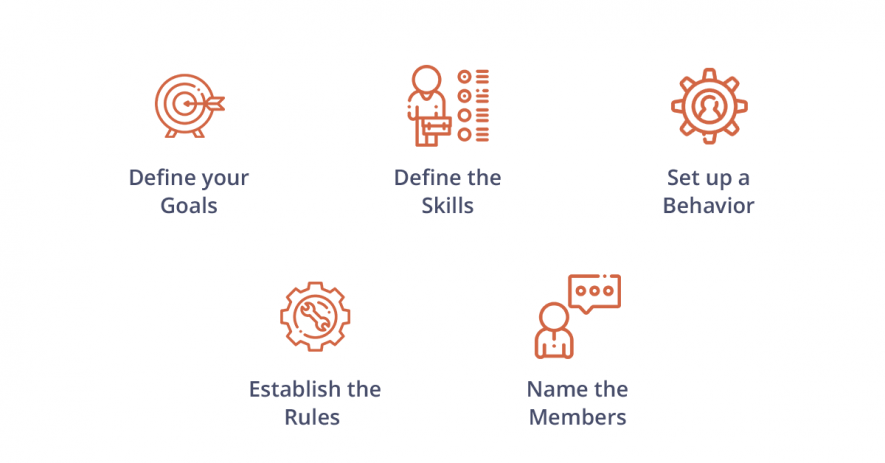- QATestLab Blog >
- QA Management >
- Team Management >
- Building a QA Team from Scratch: pros and cons
Building a QA Team from Scratch: pros and cons

The proper start is already half of the result. However, any business process may turn out to be difficult if you need to start it with a complete zero. If you are a beginner in QA, or you deal with a project that requires specific skills, you need to find a solution and an agile team can become the way out.
When it comes to attracting software testing specialists, you start asking yourself: “How to do it properly when I have nothing? How to avoid mistakes?”. To answer these questions we consulted our QA specialists, and they shared their experience of cooperation with the owner of a successful startup.
What to consider in building a QA team: expert advice
Our QA specialist Mikhail Grechukha, Game Program Manager, together with our partner, CEO and founder of a successful startup, explained to us how to build a QA team from the very beginning.
Tips from the startup owner. “Define when the task is considered to be done”, shares Gev – Ucraft’s CEO. Identify the expected end result of the project. You have to know what the completed task should be. Show your team, what goal they have to reach. It will increase the effectiveness of each action. Compare the results with planned requirements and see the level task completion.
One more tip from Gev is to “assign sub-tasks” to each particular specialist. For example, to divide the duties between manual and automation testers regarding each test.
Another one is to “specify the acceptance criteria”. Define for the testing team what is expected from testing, how it should be performed and what result is going to be reached. Build the frameworks for testing.
Finally, Gev mentioned that the QA team should be involved as early as possible. Despite the usual projects, where you can involve the QA team between “useful product” and “usable product” stages, in startup you should use the QA team assistance at the very beginning of a project.
QA team in a startup should be cost-effective. “A newly founded company has a minimum budget and a maximum of ideas and enthusiasm. In general, startups don’t have big capital. Sales? They may be, but much in the minority of cases. Because of that, the price is the core aspect for startups and their main limitations”: states QATestLab specialist Mikhail Grechukha.
Tips for PMs on how to set up the effective work of a QA team:
- prioritize tasks accurately;
- regularly analyze your productivity and always optimize processes;
- do tasks only within your assignment, do nothing for future use;
- suggest an agile cooperation model if your partner is a startup.
QA team in a startup should be oriented to use-case. “The delivery of low-quality software is not the main reason for startup failure. But because they produce the product that nobody uses and nobody cares about,” – states QATestLab project manager.
“That does not mean that you should focus QA only on ‘what features to add to please the users’ and make them buy your software. Testing in its usual form is important too. You always should keep the balance,” – shares Mikhail. He also adds on the budget issue: “You have to use the project budget as your own money”.
During the first stages of cooperation with startups, QA provider should understand the purpose of the software, its main goals, and problems the software will solve. After getting the full understanding of software specifics, the QA team should always keep these points.
When covering software with test cases, the team should focus on use cases and not all possible unrealistic scenarios that exist.
Don’t spend much time on test documentation. A startup is like a pilot product, and after getting users’ feedback, the strategy and goals may change greatly. So you only waste time and money.
Steps to Build a QA Team
We have analyzed the above comments of our experts and designed them into a basic instruction on building a QA team.

Define your goals. Define the purpose or mission of services you provide. Consider the following factors: is it a launch of a new product? Does your project require careful time-management? Is it possible to manage cost, change timeframes or adjust the scope of the project?
Define the skills of each team member. To assign tasks clearly and get maximum effectiveness from the working process, you should be aware of the skills and competencies of your team members.
Set up a behavior. The chosen candidate may be a perfect combination of skills and experience, but it could be difficult for him to meet deadlines or communicate with the rest of a team. So, in addition to profiling the skills, you should specify an expected behavior.
Establish rules and expectations. This framework will define an order of communication, division of duties, support and solution of hardships and disagreements, coordination and analysis of completed work.
Name the members which suit your expectations. Form a team and monitor the course of work. Watch the reaching of defined goals and compare it with the expectation to ensure whether the newly formed team is successfully built.
Obstacles in creating a QA team from scratch
- It is easier to adjust and modify an existing QA team than to create a new one, in case you already have some members.
- Finding, reviewing and interviewing candidates takes a lot of time which could be saved for the project by working with already involved specialists.
- Creating a new team requires the establishment of new communication and coordination among its members. The connection between the members of the existing team is more confident and stable, which accelerates project completion. Project Manager knows which approach to apply in the already formed team, unlike the new one.
Advantages of creation a QA team from scratch
- You will not need to reconfigure the team’s coordination from one type of task to another since form a team for a specific type of activity.
- You will be able to include as many specialists in the team as required by the terms of the project.
- You can select people with the specific skills that are necessary for a certain type of service.
- You can set a team to budget, time, the complexity of a particular project, the expectations of customers and adjust to these conditions already at the stage of team building, and not in the course of work.
Final Word on Building a QA Team
Each coin has two sides and it is up to you to decide whether to build a QA team on your project or the quality assurance of the product can wait. We do not assert that it is easier to create a new team, but you will feel the benefits of QA work very soon, in case you start from the very beginning. The main thing is that you already know how to set up this process.
Learn more from QATestLab
Related Posts:
- Practical tips for PM: How to build a QA Dream Team
- Quality Assurance: a must for successful projects
- Is Team Building Necessary for Software Testing?
About Article Author
view more articles
has one-year experience in blogging, technical writing, and copywriting.
View More Articles






No Comments Yet!
You can be the one to start a conversation.